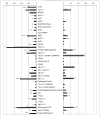The penetrance of copy number variations for schizophrenia and developmental delay
- PMID: 23992924
- PMCID: PMC4229045
- DOI: 10.1016/j.biopsych.2013.07.022
The penetrance of copy number variations for schizophrenia and developmental delay
Abstract
Background: Several recurrent copy number variants (CNVs) have been shown to increase the risk of developing schizophrenia (SCZ), developmental delay (DD), autism spectrum disorders (ASD), and various congenital malformations (CM). Their penetrance for SCZ has been estimated to be modest. However, comparisons between their penetrance for SCZ or DD/ASD/CM, or estimates of the total penetrance for any of these disorders have not yet been made.
Methods: We use data from the largest available studies on SCZ and DD/ASD/CM, including a new sample of 6882 cases and 6316 controls, to estimate the frequencies of 70 implicated CNVs in carriers with these disorders, healthy control subjects, and the general population. On the basis of these frequencies, we estimate their penetrance. We also estimate the strength of the selection pressure against CNVs and correlate this against their overall penetrance.
Results: The rates of nearly all CNVs are higher in DD/ASD/CM compared with SCZ. The penetrance of CNVs is at least several times higher for the development of a disorder from the group of DD/ASD/CM. The overall penetrance of SCZ-associated CNVs for developing any disorder is high, ranging between 10.6% and 100%.
Conclusions: CNVs associated with SCZ have high pathogenicity. The majority of the increased risk conferred by CNVs is toward the development of an earlier-onset disorder, such as DD/ASD/CM, rather than SCZ. The penetrance of CNVs correlates strongly with their selection coefficients. The improved estimates of penetrance will provide crucial information for genetic counselling.
Keywords: Autism spectrum disorder; CNV; developmental delay; penetrance; schizophrenia; selection.
Copyright © 2014 Society of Biological Psychiatry. Published by Elsevier Inc. All rights reserved.
Figures




Comment in
-
The complexity of genomic structural variation in neurodevelopmental disorders.Biol Psychiatry. 2014 Mar 1;75(5):344-5. doi: 10.1016/j.biopsych.2013.12.004. Epub 2013 Dec 18. Biol Psychiatry. 2014. PMID: 24507567 No abstract available.
References
Publication types
MeSH terms
Grants and funding
- U01 MH046276/MH/NIMH NIH HHS/United States
- R01 MH59588/MH/NIMH NIH HHS/United States
- MH083094/MH/NIMH NIH HHS/United States
- U01 MH79469/MH/NIMH NIH HHS/United States
- 090532/Z/09/Z/WT_/Wellcome Trust/United Kingdom
- R01 MH67257/MH/NIMH NIH HHS/United States
- R01 MH60870/MH/NIMH NIH HHS/United States
- 085475/Z/08/Z/WT_/Wellcome Trust/United Kingdom
- R01 MH060879/MH/NIMH NIH HHS/United States
- R01 MH81800/MH/NIMH NIH HHS/United States
- R01 MH061675/MH/NIMH NIH HHS/United States
- 5R01ES011740/ES/NIEHS NIH HHS/United States
- U01 HG004446/HG/NHGRI NIH HHS/United States
- R01 MH60879/MH/NIMH NIH HHS/United States
- G0801418/MRC_/Medical Research Council/United Kingdom
- R01 CA133996/CA/NCI NIH HHS/United States
- R01 MH59566/MH/NIMH NIH HHS/United States
- P50 CA097007/CA/NCI NIH HHS/United States
- U01 MH79470/MH/NIMH NIH HHS/United States
- 3P50CA093459/CA/NCI NIH HHS/United States
- G0601635/MRC_/Medical Research Council/United Kingdom
- P01 CA089392/CA/NCI NIH HHS/United States
- 5P50CA097007/CA/NCI NIH HHS/United States
- R01 ES011740/ES/NIEHS NIH HHS/United States
- U01 MH079469/MH/NIMH NIH HHS/United States
- R01 MH59586/MH/NIMH NIH HHS/United States
- 085475/B/08/Z/WT_/Wellcome Trust/United Kingdom
- R01 MH59587/MH/NIMH NIH HHS/United States
- R01 MH59565/MH/NIMH NIH HHS/United States
- P50 DA019706/DA/NIDA NIH HHS/United States
- R01 MH067257/MH/NIMH NIH HHS/United States
- MH 41953/MH/NIMH NIH HHS/United States
- R01 MH060870/MH/NIMH NIH HHS/United States
- R01 MH61675/MH/NIMH NIH HHS/United States
- R01 MH059571/MH/NIMH NIH HHS/United States
- R01 MH059565/MH/NIMH NIH HHS/United States
- R01 MH041953/MH/NIMH NIH HHS/United States
- P50 CA084724/CA/NCI NIH HHS/United States
- 075491/Z/04/B/WT_/Wellcome Trust/United Kingdom
- U01 MH46289/MH/NIMH NIH HHS/United States
- R01 EY020483/EY/NEI NIH HHS/United States
- U01 MH079470/MH/NIMH NIH HHS/United States
- R01 MH59571/MH/NIMH NIH HHS/United States
- R01 MH059587/MH/NIMH NIH HHS/United States
- 5R01CA133996/CA/NCI NIH HHS/United States
- 072894/Z/03/Z/WT_/Wellcome Trust/United Kingdom
- R01 MH059586/MH/NIMH NIH HHS/United States
- R01 MH059566/MH/NIMH NIH HHS/United States
- R01 MH083094/MH/NIMH NIH HHS/United States
- WT_/Wellcome Trust/United Kingdom
- 1 X01 HG005274-01/HG/NHGRI NIH HHS/United States
- R01 MH059588/MH/NIMH NIH HHS/United States
- U01 MH046318/MH/NIMH NIH HHS/United States
- G0800509/MRC_/Medical Research Council/United Kingdom
- P50 CA093459/CA/NCI NIH HHS/United States
LinkOut - more resources
Full Text Sources
Other Literature Sources
Medical

